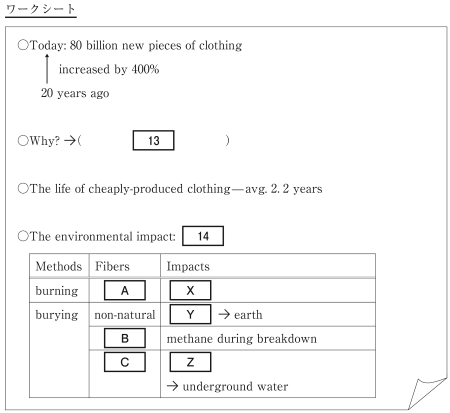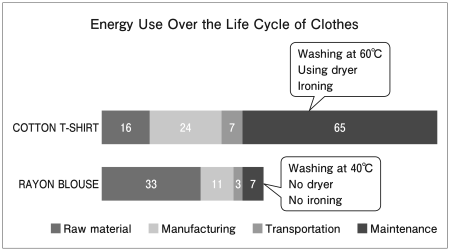【スマホで聞ける!スクリプト付き共通テスト試行】英語リスニングA平成29年度(音声・問題・正解・和訳)
第5問
問13~16
状況
アメリカの大学で,服と環境の関わりについて,講義を聞いています。

問13 ワークシートの空欄13を埋めるのに最も適切なものを,四つの選択肢(①~④)のうちから一つ選びなさい。
① carefully produced and expensive clothes
② cheaply produced and inexpensive clothes
③ poorly produced and short-lasting clothes
④ reasonably produced and long-lasting clothes
問14 ワークシートの表14の空欄A~C及びX~Zを埋めるのに最も適切な語句はどれか。Fibers の空欄A~Cのそれぞれにあてはまるものを二つの選択肢(①と②)のうちから,Impactsの空欄X~Zのそれぞれにあてはまるものを三つの選択肢(③ ~ ⑤)のうちから選びなさい。① と ② は二回以上使われることがあります。
空欄A~C:
① natural
② non-natural
空欄X~Z:
③ chemicals used in production
④ many years to break down
⑤ CO2 in the air
問15 講義で話されていると考えられる主張はどれか,四つの選択肢(① ~ ④)のうちから一つ選びなさい。
① Cotton clothes are better because they produce less CO2 and are more easily broken down than polyester clothes.
② It is better to burn textile waste than to bury it underground because harmful chemicals can damage the earth.
③ Many clothes are not recycled or reused, so buying clothing wisely could contribute to protecting the environment.
④ We should avoid buying unnecessary clothing because chemicals are used during the production process.
問13 正解 ②
問14 正解 A② B① C① X⑤ Y④ Z③
問15 正解 ③
Do you like buying new clothes? Today I’m going to talk about clothing and its connection to the environmental crisis we are facing now. Worldwide, we consume about 80 billion items of new clothing each year. That number is 400% higher than what we were consuming two decades ago. Do you know why? This increase is closely related to the fact that clothes are cheaply produced and sold at low prices. How long do you wear your clothes? The life of such cheaply produced clothing is, on average, 2.2 years. Some clothing stores are trying hard to reuse or recycle the clothes. But unfortunately, tons of clothes still end up being burned or buried as waste. Burning or burying such a large amount of textile waste adds to our present environmental crisis. Burning non-natural fibers such as polyester and nylon can produce air pollution including a huge amount of CO2.
Burying unwanted clothes also causes a lot of pollution. Do you know how long the buried clothes stay in the ground? Those non-natural fibers are basically plastics made from oil, which means they could take up to a thousand years to become part of the earth once again. In contrast, natural fibers like cotton and silk go back to the earth quickly. However, they produce greenhouse gases, such as methane, as they break down under the ground. In addition, chemicals may have been used to dye or bleach those natural fibers, and the remaining chemicals can eventually reach underground water.
clothes、clothing 衣服 connection つながり crisis 危機 face 直面する cosume 消費する billion 10億 item 品物 number 数 decade 10年間 increase 増加 closely 密接に be related to ~に関係がある fact 事実 cheaply 杏かに produce 生産する low 低い on average 平均で reuse 再利用する recycle リサイクルする unfortunately 残念ながら ton トン end up 最終的に~ burn 燃やす bury 埋める waste ゴミ、廃棄物 amount 量 textile 布地 add to 増大させる present 現在の fiber 繊維 pollution 汚染 include ~を含む huge 莫大な unwanted 不要な cause 引き起こす ground 地面 basically おおむね oil 石油 up to 最大で part 部分 earth 地面、土 in contrast 対照的に greenhouse 温室 break down 分解する in addition そのうえ chemical 化学物質 dye 染色する bleach 漂白する remain 残る evetually 最終的に underground 地下の harmful 有害な damage 害を与える wisely 賢く contribute to ~に貢献する protect 守る unnecessary 必要のない process 過程
あなたは新しい衣服を買うことは好きですか。今日、私は衣服と私たちが今直面している環境危機とのつながりについて話します。世界中で、私たちは毎年およそ800億着の新しい衣服を消費しています。その数は私たちが20年前に消費していたものより400パーセント高いです。あなたはなぜか知っていますか。この増加は、衣服が安価で生産され低い値段で売られているという事実に密接に関係があります。あなたは自分の衣服をどのくらい長く着ますか。そのように安価で生産された衣服の寿命は平均で2.2年です。いくつかの衣料品店は懸命にその衣服を再利用するかリサイクルしようとしています。しかし残念ながら、何トンもの衣服はいまだに最終的に焼却されて廃棄物として埋められています。そのような大量の布地の廃棄物を焼却したり埋めたりすることが、私たちの現在の環境機器を増大させています。ポリエステルやナイロンなどの自然のものでない繊維を燃やすことは大量のCO2を含む大気汚染を引き起こします。
また、不要な衣服を埋めることは多くの汚染を引き起こします。あなたは埋められた衣服がどのくらい長く土中に残るか知っていますか。それらの自然のものでない繊維はおおむね石油から作られたプラスチックで、それことはそれらがもう一度土の一部になるために最大で1000年かかり得ることを意味します。対照的に、綿や絹のような自然の繊維は素早く土に戻ります。しかし、それらは地下で分解するにつれてメタンのような温室効果ガスを生み出します。そのうえ、それらの自然繊維を染色し漂白するために化学物質が使われているかもしれず、残留化学物質は最終的に地下水に達することがあるのです。
問13
① 注意深い生産と高価な衣服
② 安価な生産と高価ではない衣服
③ 不十分な生産と寿命の短い衣服
④ 適度な生産と寿命の長い衣服
問14
① 自然のもの
② 自然のものではない
③ 生産に使用される化学物質
④ 分解に何年もかかる
⑤ 大気中のCO2
問15
① 綿の衣服はポリエステルの衣服よりCO2をより少なく生み出し、より簡単に分解するのでより良い。
② 有害な化学物質は土壌に害を与えることがあるので、布地の廃棄物を地下に埋めるより焼却するほうが良い。
③ 多くの衣服はリサイクルや再利用されていないので、賢く衣服を買うことは環境を保護することに貢献できるだろう。
④ 製造過程で化学物質が使われているので、私たちは必要のない衣服を買うのを避けるべきだ。
問16
講義の続きを聞いて以下の図表から読み取れる情報と,先の講義の内容を総合して,どのようなことが示唆されるか,四つの選択肢(①~④)のうちから一つ選びなさい。
① Cotton T-shirts are better for the earth when they are made out of chemical-free fibers.
② It is important not only to think of what clothes to buy but how to take care of them.
③ Rayon blouses can be recycled and as a result, last longer than cotton T-shirts.
④ We should wear natural-fiber clothing as it is friendly to the environment.

Now let’s consider how much energy is used in the life cycle of clothing. Look at this chart comparing a cotton T-shirt and a rayon blouse. Although rayon looks like a non-natural material, it is actually made from wood pulp. Notice the differences between these two types of natural-fiber clothes.
consider 考える energy エネルギー life cycle ライフサイクル chart 表 compare 比較する although ~だけれど look like ~のように見える material 素材 actually 実は pulp パルプ notice 注意する out of ~から free ~がない not only ~ but also … ~だけでなく…もまた take care of 世話をする、手入れする as a result 結果として last 続く friendly 優しい
では衣服のライフサイクルにおいてどれほどのエネルギーが使われているか考えましょう。綿のTシャツとレーヨンのブラウスを比較したこの表を見てください。レーヨンは自然のものでない素材のように見えますが実は木材のパルプから作られています。これら2種類の自然繊維の衣服の違いに注意しましょう。
① 綿のTシャツは化学物質を使わない繊維からできているとき、地球にとってより良い。
② その衣服を買うべきかだけでなくそれらをどのように手入れするかを考えることが大切である。
③ レーヨンのブラウスはリサイクルでき、結果として綿のTシャツより長持ちする。
④ 自然繊維の衣服は環境に優しいので、私たちはそれを着るべきである。
正解 ②
SNSでシェア